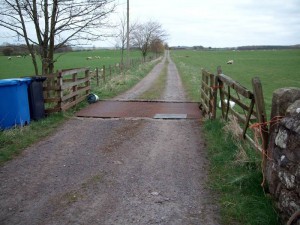Support us from £3/month
We deal with almost 1000 cases a year assisting communities, groups and individuals in protecting their local spaces and paths in all parts of England and Wales. Can you help us by joining as a member?
We are delighted with the successful outcome to Alan Kind’s appeal to the High Court, to clarify whether or not a council can lawfully authorise a cattle-grid across the full width of a footpath or bridleway. This decision will provide additional protection for our public paths and better safety for the people using them.
Capheaton bridleway 11, about 18 miles north-west of Newcastle upon Tyne, was recorded as a public footpath until 2009 when the designation was amended to bridleway, following the discovery of ‘historical evidence’ about the route, which is said to be an old packhorse road of some importance.
At some time, a cattle-grid had been placed across the whole width of the track. Walkers, and later riders and cyclists, were forced off the highway and into an adjoining field to avoid the obstruction.
Alan Kind, editor of Byway and Bridleway, the journal of the Byways and Bridleways Trust, and a local user of the route, served a statutory notice on Northumberland County Council to remove the obstruction. The matter went first to Newcastle Justices, who found against Mr Kind, and then on appeal to Newcastle Crown Court, who dismissed the appeal. During this time Northumberland County Council authorised the cattle-grid on condition that the bypass remained available to the public.
With the backing of the British Horse Society, the Byways and Bridleways Trust, the Open Spaces Society and individuals, Alan Kind, represented by Adrian Pay of New Square Chambers, appealed to the High Court. On 14 March Lord Justice Moore-Bick and Mr Justice King held for Mr Kind, confirming that a cattle grid cannot be authorised to block the whole width of a footpath or bridleway.
Northumberland County Council must now restore a legal route for the public.
This ruling follows the previous leading case concerning obstructions to public paths, Herrick v Kidner, where it was held that gateposts were obstructing a public footpath in south Somerset.
Says Alan Kind: ‘This decision, plus Peter Kidner’s case in 2010, goes a long way towards establishing firm and clear guidance on obstructions to rights of way and the duty on highway authorities to take simple, firm and prompt action to put things right.
‘Ten years ago Parliament introduced the process for the public to serve notices on highway authorities to deal with obstructions because there was a problem that needed a remedy. Plainly, some councils and landowners did not like power being put in the hands of ordinary people and have tried to undermine the process ever since. Northumberland County Council has told me that they want the law changed to give them the power to authorise gates and stiles on public paths where it sees fit. That really would be a black day for the countryside and the path-using public.’
Adds Kate Ashbrook, general secretary of the Open Spaces Society: ‘This is a milestone judgment. A cattle-grid across a path prevents walkers and riders from using that route, and we are delighted that the court has ruled that an unofficial bypass will not suffice. We are also delighted with the affirmation that the whole width of a public path must be kept free of obstruction. We congratulate Alan Kind on his courage and persistence in seeing this case through to a successful conclusion.’
Alan Kind v Northumberland County Council [2012] EWHC 603 (Admin).
See article in Special Features for more details.

